After our airline meal, Jean and I “settled back, relaxed, and enjoyed our flight to Rio.” Not. It has always amazed me that the captain has the balls to tell the passengers to “sit back, relax and enjoy the flight to blahblahblah.” UNLESS YOU ARE IN FIRST CLASS, there is NO WAY to relax and NOTHING to ENJOY about the flight. Anywhere. I get grumpy just thinking about it.
The pilot’s initial greeting was in Portuguese. It was long, flowery, sexy, and ended with not only the suggestion to enjoy the flight, but to possibly “get some” on the way. Next came the Spanish translation. Shorter, slightly less warm. Finally came the English. Three sentences: “I am Captain. We are flying. You will enjoy.” But it was still English spoken by a Latin. Still sounded like butter on pancakes.
I fidgeted my way through the rest of the flight. With all the movement, I may as well have walked to Rio. But we were finally FREE!! We had no problem finding our luggage, and went to the place where Jean told us we were going to be met by the Rio Holiday-authorized driver.
The house we had rented in Rio (actually Niterói, across the bay from Rio) came with access to a concierge, a cook/maid who would prepare breakfast each day, and a driving service. The guy who owns the outfit, Steve, lives in Washington state, I think. He is an ex-Microsoft exec who invested in nice rental real estate in Rio. Jean had researched it extensively on the internet, communicated with Steve a bunch, and the deal was great. We originally had more people on the trip when we booked the house, but despite the fact that poor “Other Nancy,” (Nancy Blackledge) couldn’t come with us, it was still cost effective. And that’s including the couple of days we couldn’t spend there, but paid for anyway, due to the length of rental required.
 So anyway, we went to the place where the driver was supposed to meet us, but of course there was no driver. Had the clusterfuck actually begun so quickly? But Jean had the number of our concierge, Sylvia, and was in immediate contact when we weren’t picked up soon. We were standing at the tourist information booth, and though they were pleasant and cute, they were no help. In addition, the maid had come to clean the counter. She sprayed stuff all over the place, then began an expert wipe-down, all the while chatting amiably with the booth girls. They were all having a high old time speaking their Portuguese. I wanted to know what they were talking about.
So anyway, we went to the place where the driver was supposed to meet us, but of course there was no driver. Had the clusterfuck actually begun so quickly? But Jean had the number of our concierge, Sylvia, and was in immediate contact when we weren’t picked up soon. We were standing at the tourist information booth, and though they were pleasant and cute, they were no help. In addition, the maid had come to clean the counter. She sprayed stuff all over the place, then began an expert wipe-down, all the while chatting amiably with the booth girls. They were all having a high old time speaking their Portuguese. I wanted to know what they were talking about.
After a bunch of speculation in English on our parts, and a bunch of “girl talk” in Portuguese on everybody else’s part, Jean got it from Sylvia that the driver had gone to the international pickup place. He didn’t know we were coming from within Brazil. But I thought we WERE at the international pickup place. Mongo confused.
Well, who cared. Our driver was here! We met halfway between the curb and the information booth. He didn’t know he was supposed to get us there, he said, in good English. But he was pissed off about the snafu, I could tell. We followed him across to the parking deck where his car was parked. Earlier, Robo had been telling me about some of the cars in Brazil that were powered with Propane and gas. Wow! Interesting, Robo! He had also told me about how they weren’t quite as powerful as a full-on gas engine. Also interesting. I didn’t know how it would apply to me other than just a neat fact.
Our driver’s car was one of those hybrids! I was looking at Jean’s and my three massive pieces of luggage, all these humanoid passengers, and then at the giant propane tank in the back of the car. How was this going to work? Between Robo, Jean and the driver, we got all the stuff in there. They piled in the back seats, and let me have the front seat again. I turned to tell the driver that I was sorry about the mixup. He immediately reminded me of Peter Dinklage, one of my favorite actors.
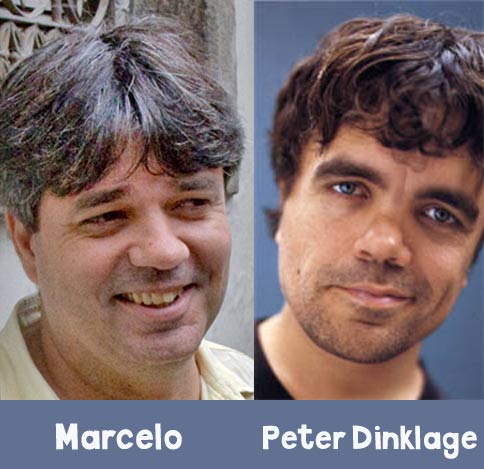 I asked him his name.
I asked him his name.
“Marcelo,” he replied.
“Well hey, Marcelo!” we all chirped. And off we went into a misting, grey day in Rio de Janeiro (pronounced “Hee-oh Zzzzhhah-NEH-ro” all the while swallowing that last “r”). Marcelo didn’t say much on the way, while we all jabbered incessantly in English. I wondered if it was as mysterious to him to hear it from us as the Portuguese was for me. We did all agree that we wanted to find a liquor store, and Jean had been Jonesing for a Bloody Mary ever since being denied one on the flight. We asked Marcelo if there was a liquor store.
It was then that I saw for the first time the expression that I would see so many more times during our stay in Rio and come to love: Marcelo would repeat the word in the interrogative, in this case “Liquor?” all the while looking in the rear view mirror, his eyebrows raised, but still at their permanently sympathetic angle. But inside that head of his, the wheels were turning at a furious rate. In this case, he was thinking, Holy shit, these people want to go to some liquor store. Everything is closed for Carnaval. I’ve got another group to pick up. (He always had somebody else to pick up after us. I felt so cheap and third-rate.)
“Well, there may be something.” He dosed out the words.
On we drove, toward Niterói. We were staying across the bay from Rio, a recommended thing from many people. Niterói is like a friendly suburb of Rio. Not that Rio is not friendly, but Niterói was spawned as a fishing village, and still has the more relaxed vibe. It’s so weird. It’s only across the bay! We drove past several beaches, asking Marcelo if we could swim there.
“Swim?” he asked. “No. I wouldn’t swim there.” He used contractions in some cases.
“What about that liquor store?” we asked.
“I think I know a place,” he repled. “But we must hurry. I have someone else to pick up. . . .”
“We’ll hurry!” we promised. Marcelo responded by driving some back streets of Niterói and finding a bodega on a street that ran perpendicular to the bay. The mist had turned to a light but steady rain.
“You have ten minutes,” Marcelo said, completely deadpan. I looked at him. “And then I’m calling the police.” I burst out laughing.
“We’ll hurry, I swear!” I vowed.
I already loved this guy.
Marcelo hung around outside, chatting with one of the men from the bodega. I got the impression that he didn’t want to crowd us, and wanted to remain at arm’s length due to whatever type of driver protocol there is in Brazil–or anywhere else. It also must be considered from his point of view: here he comes to get us after a miscommunication right out of the chute, he’s got somebody else to pick up later, and it’s US that he’s picking up. The sight of Jean’s and my luggage would have been enough to put anyone on guard.
What he didn’t know about us is that short of his being some kind of serial killer or something, we would have loved to have him hang around. The house had plenty of room. We could have made him owner for a day like they do in Salvador.
But meanwhile, we had a mission: liquor, snacks for Pettus, and Bloody Mary mix for Jean. Right. It didn’t take too terribly long to peruse every shelf in the store and find not only no Bloody Mary mix, but no tomato juice, either! It was becoming apparent that in Brazil, they don’t drink their tomatoes. (That’s one thing they’re missing! And they COULDA had a V-8! Maple syrup is another thing that’s rare as hen’s teeth there. Carol had us bring a couple of jugs of it to her. In Salvador, a 6 oz. bottle was like 30 Reais, or fifteen bucks!)
There were several people working in there, all friendly and smiley,especially after my mangled “boa-tarde” to each one of them. I found the guy who looked like the owner: he was mopping and ordering everybody around at the same time. I tried to ask for tomato first, then juice. No way that was gonna work. I held up my finger politely for a pause and dashed outside to ask Marcelo what the Portuguese word was for “tomato”.
“Tomate,” (kind of pronounced toe-mah-tay) he said. Why I didn’t ask him for the name of the whole finished product in juice form, I’ll never know. I headed back in and said “toe-mah-tay” to the man and then did the drinky-drinky motion. Ahh! he understood! He pulled me to the back to show me the fresh tomatoes.
Finger up. “Desculpe,” I said. Out to talk to Marcelo. All the while, a tall guy had been standing by watching this Berlitz opera play out. After some speedy Portuguese with Marcelo, he relayed their conclusions to the owner.
“Ahh! Tomatksvvi;ahjlav0diu!” he beamed, understanding. A golden pause. “Não,” he concluded, his face losing its glow.
I was crushed. Jean was crushed. I had begun to feel the lure of a good old BM, myself and this was indeed distressing news. Not for the tall guy! He said something to the manager, then disappeared out the door. We stood around kind of looking at everything politely, having no idea what he had gone to do. Robo and I were standing there with our liquor purchases. Vodka and, you guessed it, Bacardi Gold.
Were we supposed to wait? Marcelo was still standing outside, and our ten minutes were UP! I stuck my head out the door and hollered, “Don’t call the police!” Marcelo’s eyes disappeared under the canopy of eyebrows as he let out a laugh that made him my international brother instantly. “No,” he said. Surely he was beginning to think that maybe, just maybe, we weren’t assholes. Quite a breakthrough, in my opinion.
Back inside, Pettus had paid, and decided to come back in and look for something else. Whatever it was, it wasn’t there, and she tried to get back out to go to the car. The elaborate turnstile system was of a design that none of us could decipher. She started asking one of the guys how to get out, mainly by pointing, and trying to say “saida” (exit). He handed her a pack of batteries with a quizzical look on his face. “No,” Pettus said, laughingly exasperated. “Saida.” I was no help. All I could do was watch and wait for the tall guy. Pettus’ new friend then handed her some water. “No,” she said, shaking her head and making a lunging movement with her arm toward the door. The cashier, enjoying the spectacle, finally clued in to what Pettus really wanted, and let her out.
Just then, the tall guy reappeared with two tiny cans of tomato juice! We all cheered, I “obrigado”ed the shit out of him and everybody else, and told the owner how beleza his store was. Believe it or not, I was not sweating at this time, so I had to leave the “suado” card in my pocket. We laughingly piled into Marcelo’s car. The rain had picked up, and we still had to find Mirante de São Francisco, our house for the stay.

 Wow! Idyllic.
Wow! Idyllic. Once back inside, we saw that Robson and crew had taken the luggage down one floor to the bedrooms. There were three on the floor, the master bedroom suite featuring all the steam/jacuzzi stuff of hedonist dreams. We gave that bedroom to Pettus and Robo and took the one nearest the stairs. It was cozy goodness. There was a balcony that ran the length of the house on this floor as well, but we never went out on it, of course. It was the kind of thing that a vacationer would use only after having exhausted all other Rio entertainment. We didn’t have that kind of time.
Once back inside, we saw that Robson and crew had taken the luggage down one floor to the bedrooms. There were three on the floor, the master bedroom suite featuring all the steam/jacuzzi stuff of hedonist dreams. We gave that bedroom to Pettus and Robo and took the one nearest the stairs. It was cozy goodness. There was a balcony that ran the length of the house on this floor as well, but we never went out on it, of course. It was the kind of thing that a vacationer would use only after having exhausted all other Rio entertainment. We didn’t have that kind of time. She led us downstairs to the bottom floor for our orientation and our first caipirinhas. The basement area was incredible, painted a gorgeous Pantone 361 green. The stairs ended in a large wet bar with refrigerator and drinking water machine, the bottle hidden by a needlepointed cover that said “Rio Holiday,” bearing a sign that said “WE DRINK BOTTLED WATER HERE.” I gave an involuntary shudder at what was obviously another message from Iemanjá.
She led us downstairs to the bottom floor for our orientation and our first caipirinhas. The basement area was incredible, painted a gorgeous Pantone 361 green. The stairs ended in a large wet bar with refrigerator and drinking water machine, the bottle hidden by a needlepointed cover that said “Rio Holiday,” bearing a sign that said “WE DRINK BOTTLED WATER HERE.” I gave an involuntary shudder at what was obviously another message from Iemanjá. NOT SO FAST, BURFORD.
NOT SO FAST, BURFORD. Ahh, yes. The FREE long distance. It became my three companions’ major obsession getting it to work. They kept talking in carrier-ese, and saying stuff about Seattle that I didn’t understand. Jean talked to a couple of people, Sylvia first, and I believe it was fixed in a couple of days. Who knows? I didn’t want to call anybody. I wanted to figure out the dern TV so I could have some more Brazilian video fun.
Ahh, yes. The FREE long distance. It became my three companions’ major obsession getting it to work. They kept talking in carrier-ese, and saying stuff about Seattle that I didn’t understand. Jean talked to a couple of people, Sylvia first, and I believe it was fixed in a couple of days. Who knows? I didn’t want to call anybody. I wanted to figure out the dern TV so I could have some more Brazilian video fun. Two other very, very important things happened this night.
Two other very, very important things happened this night. Jean called Sylvia. Sylvia was going to call Marcelo. We hung around waiting for the deal to go down, everybody checking email in rotation, me alternately standing in front of the fans and walking out on the balcony to see if the weather had changed. We heard a horn, grabbed our stuff, (my camera in relaxed duffel position 2, Jean’s myriad envelopes and massive purse, along with super-travel-sized Ziplocs of only about one-tenth of the medicine inventory, Robo with his little bitty video camera, and Pettus unencumbered as always) and rushed out to meet Marcelo.
Jean called Sylvia. Sylvia was going to call Marcelo. We hung around waiting for the deal to go down, everybody checking email in rotation, me alternately standing in front of the fans and walking out on the balcony to see if the weather had changed. We heard a horn, grabbed our stuff, (my camera in relaxed duffel position 2, Jean’s myriad envelopes and massive purse, along with super-travel-sized Ziplocs of only about one-tenth of the medicine inventory, Robo with his little bitty video camera, and Pettus unencumbered as always) and rushed out to meet Marcelo.
 We were itchy to get to Copacabana and pick up our Carnaval tickets. Jean had been dealing with several brokers at one location, going back and forth from elated to bummed out to broke to thrifty. We had finally landed on seats in Sector 7, which is for the locals. The tourist sector has reserved seats, but the only ones left were right on the ground. None of us thought that would be as good, and opted for taking our chances in Sector 7, which has no reserved seats. You just got there and plopped down, kind of like at a high school football game. The brokers assured us it would be a great Carnaval experience, and the tickets cost less than tourist sector. After having been once, I can see how it might be an interesting alternative to be at ground level–but not with the tourists–definitely with the locals.
We were itchy to get to Copacabana and pick up our Carnaval tickets. Jean had been dealing with several brokers at one location, going back and forth from elated to bummed out to broke to thrifty. We had finally landed on seats in Sector 7, which is for the locals. The tourist sector has reserved seats, but the only ones left were right on the ground. None of us thought that would be as good, and opted for taking our chances in Sector 7, which has no reserved seats. You just got there and plopped down, kind of like at a high school football game. The brokers assured us it would be a great Carnaval experience, and the tickets cost less than tourist sector. After having been once, I can see how it might be an interesting alternative to be at ground level–but not with the tourists–definitely with the locals.
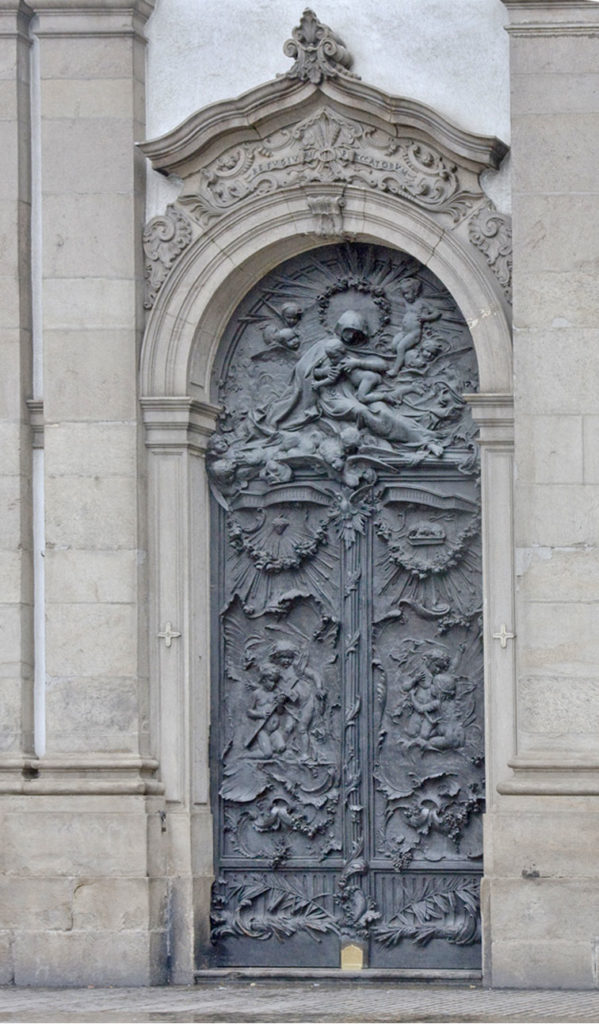
 Somehow, this gorgeous Cathedral had escaped the insult of graffiti, as far as I could tell. Across the street was the Palacio Tiradentes, an old public building that was now serving as a museum. During our various excursions around Rio, Marcelo would point out several historic buildings that were now museums. I liked that.
Somehow, this gorgeous Cathedral had escaped the insult of graffiti, as far as I could tell. Across the street was the Palacio Tiradentes, an old public building that was now serving as a museum. During our various excursions around Rio, Marcelo would point out several historic buildings that were now museums. I liked that.
 In front of this fantastic building was a statue of Tiradentes, Brazil’s number one martyr. Marcelo gave us the lowdown. (Man! He knew a bunch about Brazilian history!) In a nutshell, during the late 1700s, Portugal was taking Brazil’s gold (a true motherlode) rapidly, and using the Brazilians to mine it. When they mined less than Portugal expected, they were taxed on the difference. Tiradentes saw the heinous inequity, and plotted to overthrow the whole rotten deal and establish freedom for the people. He was betrayed by a man he believed to be a friend and compatriot. Tiradentes was arrested, hanged, then quartered, his body parts marched throughout Rio and sections of Brazil to truly quash any type of rebellion they may have had in mind. I hate people that do stuff like that.
In front of this fantastic building was a statue of Tiradentes, Brazil’s number one martyr. Marcelo gave us the lowdown. (Man! He knew a bunch about Brazilian history!) In a nutshell, during the late 1700s, Portugal was taking Brazil’s gold (a true motherlode) rapidly, and using the Brazilians to mine it. When they mined less than Portugal expected, they were taxed on the difference. Tiradentes saw the heinous inequity, and plotted to overthrow the whole rotten deal and establish freedom for the people. He was betrayed by a man he believed to be a friend and compatriot. Tiradentes was arrested, hanged, then quartered, his body parts marched throughout Rio and sections of Brazil to truly quash any type of rebellion they may have had in mind. I hate people that do stuff like that.
 We wandered further across the square, to where the old port was located. Marcelo explained that in the early 1900s, Rio had expanded their land mass by filling in part of the bay with old garbage and dirt, and making new real estate! This was part of an archaeological excavation that revealed the original port and structure fronting it. Elsewhere in Rio, there are remants of an ancient aqueduct that serviced the city. These pictures are particularly cool, with the old port structure juxtaposed with the modern mirror-fronted building behind it. The next picture features a local and his possessions. Was he homeless? I didn’t know. Marcelo didn’t volunteer any information if he had it.
We wandered further across the square, to where the old port was located. Marcelo explained that in the early 1900s, Rio had expanded their land mass by filling in part of the bay with old garbage and dirt, and making new real estate! This was part of an archaeological excavation that revealed the original port and structure fronting it. Elsewhere in Rio, there are remants of an ancient aqueduct that serviced the city. These pictures are particularly cool, with the old port structure juxtaposed with the modern mirror-fronted building behind it. The next picture features a local and his possessions. Was he homeless? I didn’t know. Marcelo didn’t volunteer any information if he had it.

 After wandering through the alley, we came upon this sculpture that I swore I had seen before. I knew it was by a famous artist! I made Jean, Pettus and Robo pose by it. Their expressions tell the tale: “He’s an idiot.”
After wandering through the alley, we came upon this sculpture that I swore I had seen before. I knew it was by a famous artist! I made Jean, Pettus and Robo pose by it. Their expressions tell the tale: “He’s an idiot.” Well, I’m NOT! When I finally saw all my pictures, I realized that I had seen this very sculpture, or its brother, outside in Salvador at the Museum of Modern Art. HA! I emailed Carol, who did the research necessary to find out that the artist is José Resende. The work is untitled.
Well, I’m NOT! When I finally saw all my pictures, I realized that I had seen this very sculpture, or its brother, outside in Salvador at the Museum of Modern Art. HA! I emailed Carol, who did the research necessary to find out that the artist is José Resende. The work is untitled. We exited the series of alleys onto a stellar view of the
We exited the series of alleys onto a stellar view of the 

 That boy can make a face, can’t he? It’s amazing the way he can contort those Nordic good looks into such great expressions. He and Pettus are both incredibly photogenic, and look like they stepped off the pages of some calendar for “Ski Stockholm” or something. The last photo shoot I did, I was playing “obnoxious car salesman sitting in hot tub talking on cell phone.” Enhhh. It’s a living.
That boy can make a face, can’t he? It’s amazing the way he can contort those Nordic good looks into such great expressions. He and Pettus are both incredibly photogenic, and look like they stepped off the pages of some calendar for “Ski Stockholm” or something. The last photo shoot I did, I was playing “obnoxious car salesman sitting in hot tub talking on cell phone.” Enhhh. It’s a living.



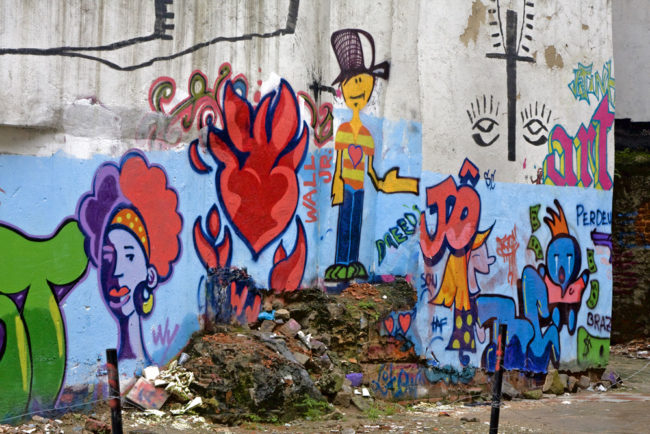 On the way back over the bridge to Niterói, I was able to snap some great shots of all the cranes and industry that lined both sides of the bridge. Rio is a huge car producer, which blew my mind. That’s the good news/bad news for Brazil, I think. They are so ripe for becoming a big economic success, with resources out the ass, and a good potential labor force. But a lot of the success seems to rest on the back of the rainforest. Is it fair to deny these people the economic success we have? Is it fair to screw up the world by raping the country’s vital ecologial underpinnings? I never did get Marcelo’s take on all of this, but I suspect, with his love and knowledge of nature (which we discovered later), he would be opposed to wholesale pillage of the jungle.
On the way back over the bridge to Niterói, I was able to snap some great shots of all the cranes and industry that lined both sides of the bridge. Rio is a huge car producer, which blew my mind. That’s the good news/bad news for Brazil, I think. They are so ripe for becoming a big economic success, with resources out the ass, and a good potential labor force. But a lot of the success seems to rest on the back of the rainforest. Is it fair to deny these people the economic success we have? Is it fair to screw up the world by raping the country’s vital ecologial underpinnings? I never did get Marcelo’s take on all of this, but I suspect, with his love and knowledge of nature (which we discovered later), he would be opposed to wholesale pillage of the jungle.

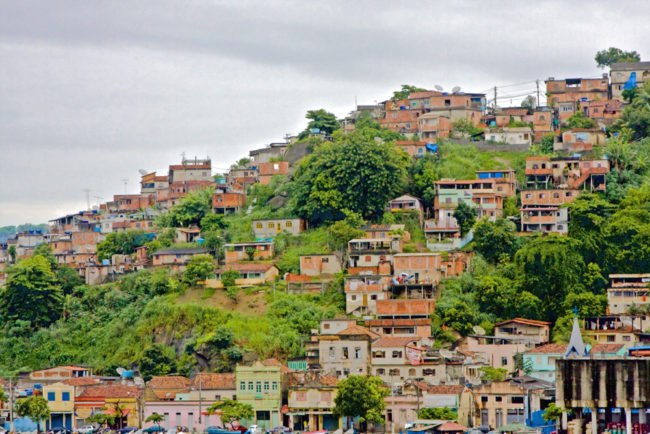 </ a>
</ a> We passed through the toll booths into Niterói. There were signs advertising a “fast pass” sort of thing that involved a bulk payment and then free access back and forth. Marcelo told us how he had purchased one of those once. Immediately after he bought it and tried to get through, he was stopped for a reason unknown to him, and the “guy” took his pass away and sent him on. HUH??? Marcelo had no explanation for it either.
We passed through the toll booths into Niterói. There were signs advertising a “fast pass” sort of thing that involved a bulk payment and then free access back and forth. Marcelo told us how he had purchased one of those once. Immediately after he bought it and tried to get through, he was stopped for a reason unknown to him, and the “guy” took his pass away and sent him on. HUH??? Marcelo had no explanation for it either.

 Good googly GOOT! The place was packed! And everything was wet from a recent shower. At least we weren’t there for that. We surveyed the situation, and finally found a spot, of course halfway down an aisle. Pettus led, followed by Robo, Jean and then me. I was the caboose powered by a poor rendition of liçensa, a shortening of the expression for “excuse me.” Nobody seemed particularly bothered by us, and many returned my expectant smile immediately.
Good googly GOOT! The place was packed! And everything was wet from a recent shower. At least we weren’t there for that. We surveyed the situation, and finally found a spot, of course halfway down an aisle. Pettus led, followed by Robo, Jean and then me. I was the caboose powered by a poor rendition of liçensa, a shortening of the expression for “excuse me.” Nobody seemed particularly bothered by us, and many returned my expectant smile immediately. Unidos da Tijuca (referred to as Tijuca) was coming slowly from our right. The first thing we saw, besides the blue and yellow flags that we were frantically waving, was a gigantic blue and gold peacock who would furl and unfurl its wings in time to the music that I hadn’t caught onto yet, blaring tastefully and pleasingly from the speakers that lined the runway. Nice, we all thought. What kind of motor would that take, Robo and I wondered. And then we discovered that the peacock’s epidermis was homo sapiens, and its feathers were controlled by same. Meu Deus!
Unidos da Tijuca (referred to as Tijuca) was coming slowly from our right. The first thing we saw, besides the blue and yellow flags that we were frantically waving, was a gigantic blue and gold peacock who would furl and unfurl its wings in time to the music that I hadn’t caught onto yet, blaring tastefully and pleasingly from the speakers that lined the runway. Nice, we all thought. What kind of motor would that take, Robo and I wondered. And then we discovered that the peacock’s epidermis was homo sapiens, and its feathers were controlled by same. Meu Deus!


 Notice the people hanging out of the camarotes. They’re the private boxes that you can buy a regular old ticket for, or come to party with one of the several companies, etc. that rent them for the event. Also notice the furry blue bears and the closeup that follows: cutout belly and vents galore.
Notice the people hanging out of the camarotes. They’re the private boxes that you can buy a regular old ticket for, or come to party with one of the several companies, etc. that rent them for the event. Also notice the furry blue bears and the closeup that follows: cutout belly and vents galore.



 But then they’d throw in this dash of Rowrrrrr with the genie girls, and it would balance out into some kind of Twin Peaks fantasy.
But then they’d throw in this dash of Rowrrrrr with the genie girls, and it would balance out into some kind of Twin Peaks fantasy. The way these parades worked is, they would intersperse the basic elements: floats, highly trained participants, lightly trained participants, percussion sections, samba steppers only, movie and TV stars in duos as flag couples, and movie and TV stars solo and in tiny costumes like they should be. There is a rule against any genital nudity, and a g-string is required for all hotties. The stars would have their own performing areas, and were like little dabs of rich chocolate on a dessert. The choreographers spaced everything perfectly. The blue bears you saw above were one-time samba steppers. The guy in the big hoop skirt was probably a part-timer, and the dolls doing the big gig in the dollhouse were surely full-timers. But what do I know, really?
The way these parades worked is, they would intersperse the basic elements: floats, highly trained participants, lightly trained participants, percussion sections, samba steppers only, movie and TV stars in duos as flag couples, and movie and TV stars solo and in tiny costumes like they should be. There is a rule against any genital nudity, and a g-string is required for all hotties. The stars would have their own performing areas, and were like little dabs of rich chocolate on a dessert. The choreographers spaced everything perfectly. The blue bears you saw above were one-time samba steppers. The guy in the big hoop skirt was probably a part-timer, and the dolls doing the big gig in the dollhouse were surely full-timers. But what do I know, really?
 This was followed by two 25 foot tall, bald, topless fairies. Fantastic bodies, but glitter for hair, and slightly menacing expressions. Compare their size to the operator on the ground and the people gawking from the camarotes. On the heels of the dollhouse, this was also visually thrilling and unsettling. The giant multicolored pixies were moving up and down in time to the music as well, due to the people on the float producing sympathetic vibrations, but in other cases from a hidden operator inside. I was beginning to feel the vibe of the Rio designers, and how it compared with Carnival that I’m familiar with in Mobile and New Orleans: gaudy, wild, scary, funny, mysterious, otherworldly. But Rio had them beat, hands down. This was serious, fun and fantastic entertainment.
This was followed by two 25 foot tall, bald, topless fairies. Fantastic bodies, but glitter for hair, and slightly menacing expressions. Compare their size to the operator on the ground and the people gawking from the camarotes. On the heels of the dollhouse, this was also visually thrilling and unsettling. The giant multicolored pixies were moving up and down in time to the music as well, due to the people on the float producing sympathetic vibrations, but in other cases from a hidden operator inside. I was beginning to feel the vibe of the Rio designers, and how it compared with Carnival that I’m familiar with in Mobile and New Orleans: gaudy, wild, scary, funny, mysterious, otherworldly. But Rio had them beat, hands down. This was serious, fun and fantastic entertainment.
 The next float was populated by sexy girls, guys in top hat and tails, and a chandelier with human candles. I believe this float represented time, or elegant furnishings, one. I don’t believe I could keep up the payments on THAT kind of light fixture.
The next float was populated by sexy girls, guys in top hat and tails, and a chandelier with human candles. I believe this float represented time, or elegant furnishings, one. I don’t believe I could keep up the payments on THAT kind of light fixture.

 Speaking of extinction, next came my favorite bunch of samba steppers in the Tijuca show, and probably the whole thing: the dinosaur guys! Their bony heads and tails produced a delightful synchronized wiggling with the music that was funny and mesmerizing.
Speaking of extinction, next came my favorite bunch of samba steppers in the Tijuca show, and probably the whole thing: the dinosaur guys! Their bony heads and tails produced a delightful synchronized wiggling with the music that was funny and mesmerizing.

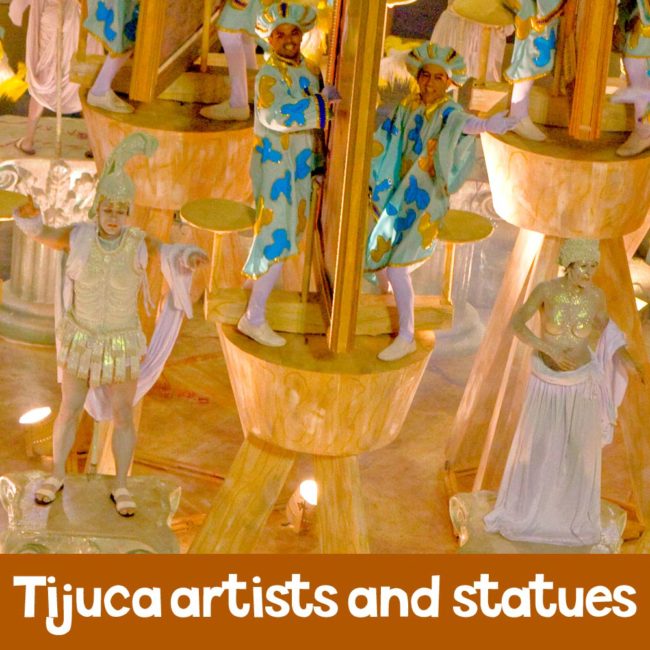
 All of Tijuca’s blinding excess came to an end just as all the schools did: with the cleanup crew. I couldn’t help but flash to the end of “Peabody’s Improbable History” on the
All of Tijuca’s blinding excess came to an end just as all the schools did: with the cleanup crew. I couldn’t help but flash to the end of “Peabody’s Improbable History” on the  It was at this point when Robo paused his video camera, turned to us, and said in a tone dry as sand, “I’ve seen better.” I thought I was gonna fall off the bleachers. But our new friends, somehow having no trouble understanding what was said, completely missed the hilarity of the understatement. They whipped around to look at Robo with faces that were very easy to read.
It was at this point when Robo paused his video camera, turned to us, and said in a tone dry as sand, “I’ve seen better.” I thought I was gonna fall off the bleachers. But our new friends, somehow having no trouble understanding what was said, completely missed the hilarity of the understatement. They whipped around to look at Robo with faces that were very easy to read. The guy’s sister sitting next to me was Flávia Rios, a lawyer from Rio. She was ebullient, friendly, and made us all glad we had picked those seats. The friends she had with her were equally pleasant, but she was clearly the ringleader of fun. I tried all the Portuguese on her I had in my bag, and eventually began mixing it with Spanish, which she was more familiar with than English or my mishandling of her verbs and nouns. Around this time, one of the many vendors climbed the bleachers stepping through the crowd like he was dodging land mines. It was amazing. Their balance while holding giant coolers on their shoulders was uncanny. Then being able to park in front of their customers, cooler on a bended knee, while hardly causing a stir at all–it was more than I could take in. Flávia bought us a beer just as the massive explosion of fireworks to our east announced the arrival of Imperatriz.
The guy’s sister sitting next to me was Flávia Rios, a lawyer from Rio. She was ebullient, friendly, and made us all glad we had picked those seats. The friends she had with her were equally pleasant, but she was clearly the ringleader of fun. I tried all the Portuguese on her I had in my bag, and eventually began mixing it with Spanish, which she was more familiar with than English or my mishandling of her verbs and nouns. Around this time, one of the many vendors climbed the bleachers stepping through the crowd like he was dodging land mines. It was amazing. Their balance while holding giant coolers on their shoulders was uncanny. Then being able to park in front of their customers, cooler on a bended knee, while hardly causing a stir at all–it was more than I could take in. Flávia bought us a beer just as the massive explosion of fireworks to our east announced the arrival of Imperatriz.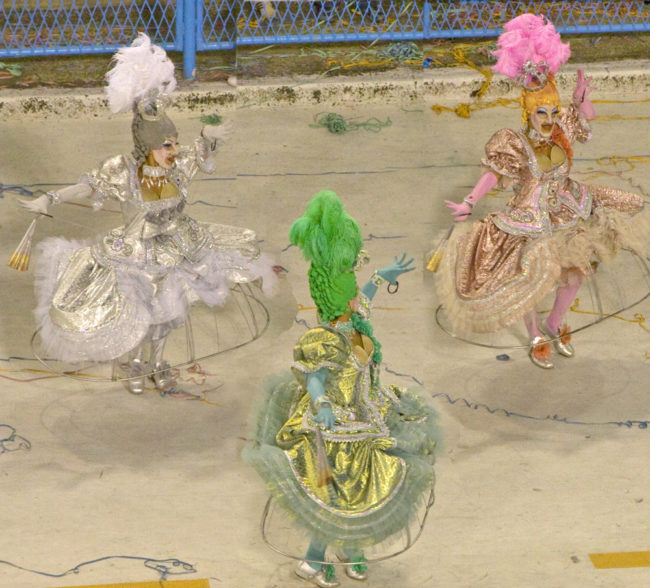 I began to notice more about the parades, like the existence of a gaggle of sideline coaches and conductors. This guy could just as well be working a soccer match, with that pose.
I began to notice more about the parades, like the existence of a gaggle of sideline coaches and conductors. This guy could just as well be working a soccer match, with that pose. I had a hard time figuring out who these next guys were supposed to be. Were they the King and Maria in bedclothes with the beds attached? Were those things mirrors? I had no idea. The picture looks like these folks are kind of panicking because they’re tangled up or something.
I had a hard time figuring out who these next guys were supposed to be. Were they the King and Maria in bedclothes with the beds attached? Were those things mirrors? I had no idea. The picture looks like these folks are kind of panicking because they’re tangled up or something. I wasn’t quite sure what the next two groups were. I think they were fancy men followed by fancy women. Don’t tell me those costumes aren’t hot as hell.
I wasn’t quite sure what the next two groups were. I think they were fancy men followed by fancy women. Don’t tell me those costumes aren’t hot as hell. Flávia told me that the flag couple were stars in Brazil, and that most of the solo hotties were, as well. That was the first I had heard of this phenomenon, but it made sense. It also would help in the competition to have a huge star in your show. There were many elements that made up the judges’ eventual score, and that was just one of them. I read that the performance of these flag-bearing couples can rack up 40 points. It didn’t say out of how many total, but it sounded important nevertheless.
Flávia told me that the flag couple were stars in Brazil, and that most of the solo hotties were, as well. That was the first I had heard of this phenomenon, but it made sense. It also would help in the competition to have a huge star in your show. There were many elements that made up the judges’ eventual score, and that was just one of them. I read that the performance of these flag-bearing couples can rack up 40 points. It didn’t say out of how many total, but it sounded important nevertheless. All of the floats had poles for the riders to hold onto. When everybody starts to samba together on one of those things, the sway is rhythmic and can be rather drastic. Without the poles, they’d be flinging people into the crowd from both sides. I think it would be kind of scary to ride on one, being such a vertiginous sort.
All of the floats had poles for the riders to hold onto. When everybody starts to samba together on one of those things, the sway is rhythmic and can be rather drastic. Without the poles, they’d be flinging people into the crowd from both sides. I think it would be kind of scary to ride on one, being such a vertiginous sort.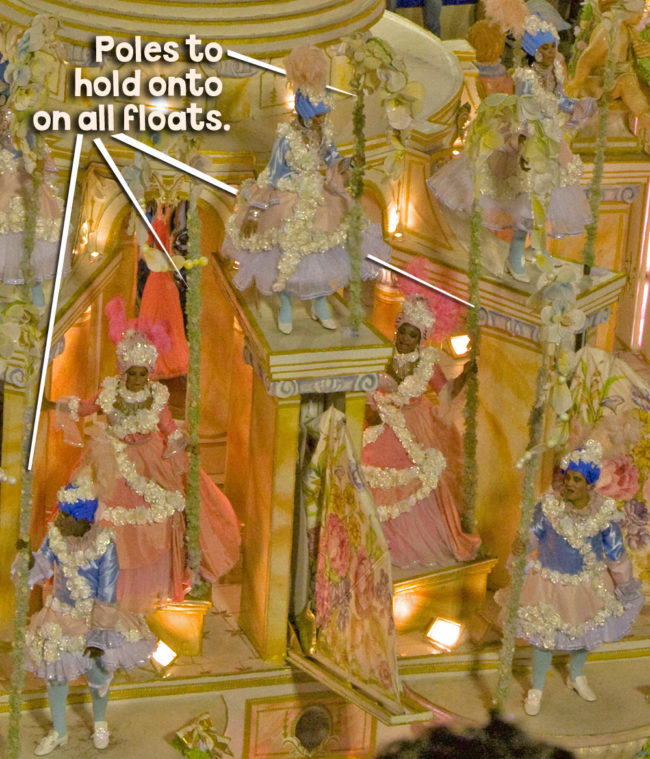 The next float looks like a representation of the French Revolution. Uhh. Yeah. Marie Antoinette and all.
The next float looks like a representation of the French Revolution. Uhh. Yeah. Marie Antoinette and all.

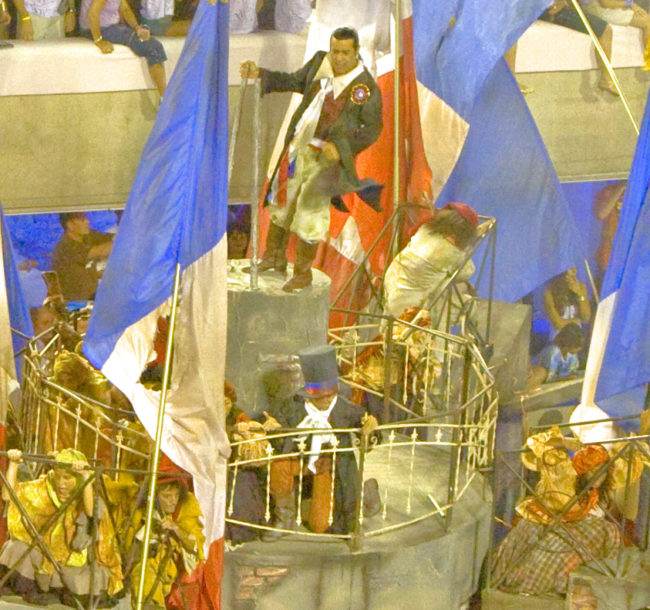 Next came the Brazilian hottie. She was an exotic bird on acid as she pranced her beautiful self around. The picture of the conductor and the single percussion guy looks like he’s telling him not to come yet–the star was still performing in that space. I don’t know, though, he could have been a star in his own right, and doing a little tambourine solo or something.
Next came the Brazilian hottie. She was an exotic bird on acid as she pranced her beautiful self around. The picture of the conductor and the single percussion guy looks like he’s telling him not to come yet–the star was still performing in that space. I don’t know, though, he could have been a star in his own right, and doing a little tambourine solo or something.
 The golden twirlers that followed were so very cool. You can’t tell anything from a still picture, but when all that gold starts rotating at the same time, changing directions like birds in flight, it is mind blowing. Plus, you couldn’t see their arms so well under those enormous costumes. Woo-WEE!
The golden twirlers that followed were so very cool. You can’t tell anything from a still picture, but when all that gold starts rotating at the same time, changing directions like birds in flight, it is mind blowing. Plus, you couldn’t see their arms so well under those enormous costumes. Woo-WEE! The gigantic horses that followed the golden girls were impressive, to say the least. Especially the way they trotted in time to the music. Part sympathetic vibrations, yes, but was somebody moving them? I don’t know if that was true in this case. This float was an eye-popper with two bigwigs on top. I would think the horses would have gotten tired from pulling not only the coach with all those people, but the house as well. The guy in the green jumpsuit looks half like a trainer and half like the guy who is in charge of scooping up giant
The gigantic horses that followed the golden girls were impressive, to say the least. Especially the way they trotted in time to the music. Part sympathetic vibrations, yes, but was somebody moving them? I don’t know if that was true in this case. This float was an eye-popper with two bigwigs on top. I would think the horses would have gotten tired from pulling not only the coach with all those people, but the house as well. The guy in the green jumpsuit looks half like a trainer and half like the guy who is in charge of scooping up giant  Dolphins and parakeets followed the horses. I didn’t know what they represented, but now think they show the King’s passage to Brazil and his discovery of dolphins and parakeets.
Dolphins and parakeets followed the horses. I didn’t know what they represented, but now think they show the King’s passage to Brazil and his discovery of dolphins and parakeets. Following my theory, this next group are the new types of cooks he met in Brazil, and the new foods that he found here.
Following my theory, this next group are the new types of cooks he met in Brazil, and the new foods that he found here.



 The favorite thing found by the King when he came to Brazil was gold. It had already caused all kinds of trouble and resulted in meanness and body parts toted through the city. I wonder if the bankers were the ones who wanted to represent gold.
The favorite thing found by the King when he came to Brazil was gold. It had already caused all kinds of trouble and resulted in meanness and body parts toted through the city. I wonder if the bankers were the ones who wanted to represent gold. It’s fun trying to put my made up Brazilian history with what I think these floats are. Therefore, I will tell you that this next float represents the botanical gardens that were started by King John VI. And yes, after a quickie Google, I find that this was indeed the king that graced the city with one of the most stunning gardens in the world. But I should have known that already, because Marcelo told us all about it when we saw them in all their glory ourselves. Stupid! Stupid! Stupid!
It’s fun trying to put my made up Brazilian history with what I think these floats are. Therefore, I will tell you that this next float represents the botanical gardens that were started by King John VI. And yes, after a quickie Google, I find that this was indeed the king that graced the city with one of the most stunning gardens in the world. But I should have known that already, because Marcelo told us all about it when we saw them in all their glory ourselves. Stupid! Stupid! Stupid!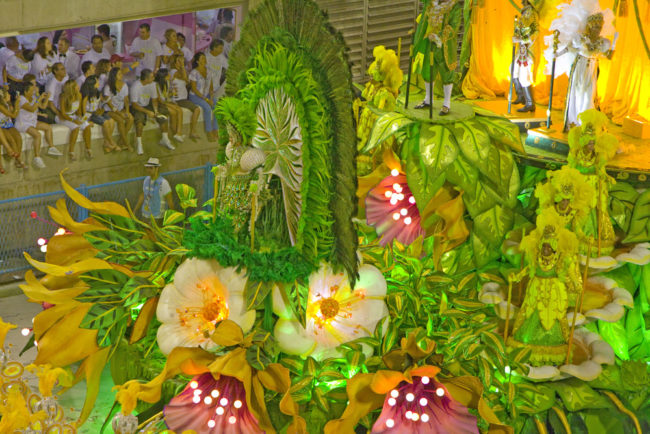

 The last float featured people in weird poodle puff outfits representing what I don’t know. It surely was also peopled with members of the old guard, who had been with Imperatriz for years, or were important to the school. They played big parts on many floats as well, and were sprinkled throughout the performance in key places.
The last float featured people in weird poodle puff outfits representing what I don’t know. It surely was also peopled with members of the old guard, who had been with Imperatriz for years, or were important to the school. They played big parts on many floats as well, and were sprinkled throughout the performance in key places.

 Vila Isabel had exploded in the east with the traditional fireworks, but in tech savvy Rio of the 21st century, every parade was accompanied by the garish flashing of sponsorships on a huge digital screen. For some (smart) reason, they went for maximum overdrive on the flashing, and it blended almost comfortably with the pyrotechnics and the lineup to follow.
Vila Isabel had exploded in the east with the traditional fireworks, but in tech savvy Rio of the 21st century, every parade was accompanied by the garish flashing of sponsorships on a huge digital screen. For some (smart) reason, they went for maximum overdrive on the flashing, and it blended almost comfortably with the pyrotechnics and the lineup to follow. Flávia and I had become real buddies by this time (translated “several beers each”), and she began to tell me about good bars for us to visit in Rio.
Flávia and I had become real buddies by this time (translated “several beers each”), and she began to tell me about good bars for us to visit in Rio. The first big float was a couple of winged horses with fish tails bearing psychedelic compasses. Beautiful, stately and trippy all at the same time, I erroneously dub them “Pegasus.” The glow underneath was like some people put under their cars in blue or purple. I personally love it, though Jean would probably not support an expenditure for such an accessory on my Honda.
The first big float was a couple of winged horses with fish tails bearing psychedelic compasses. Beautiful, stately and trippy all at the same time, I erroneously dub them “Pegasus.” The glow underneath was like some people put under their cars in blue or purple. I personally love it, though Jean would probably not support an expenditure for such an accessory on my Honda. Aha! My first sighting of “the great and powerful Oz” in the belly of Pegasus 1 (or is it 2). And for a flying horse, this nag sure needs a lot of guys to push.
Aha! My first sighting of “the great and powerful Oz” in the belly of Pegasus 1 (or is it 2). And for a flying horse, this nag sure needs a lot of guys to push. Being that I have no inkling what the dual Pegasi had to do with workers in Brazil, I’ll now proceed with a great and valid account of what was to follow from Vila Isabel’s bag of tricks.
Being that I have no inkling what the dual Pegasi had to do with workers in Brazil, I’ll now proceed with a great and valid account of what was to follow from Vila Isabel’s bag of tricks.

 Once again, I will remind you, these girls are play acting.
Once again, I will remind you, these girls are play acting. How do you reckon these girls got this cushy gig? Being delightfully half naked in a shower of cool water for the good of your samba school? For mankind? Carámba! Does that look like Hillary Swank or WHAT? Surely these girls were not warriors, but, like, fashion coordinators or enablers for the Amazons themselves. There is no other explanation.
How do you reckon these girls got this cushy gig? Being delightfully half naked in a shower of cool water for the good of your samba school? For mankind? Carámba! Does that look like Hillary Swank or WHAT? Surely these girls were not warriors, but, like, fashion coordinators or enablers for the Amazons themselves. There is no other explanation. This next little blast of samba-steppers represented the Amazon once the women decided to let the men in. Coordination of colors. Orderliness. Hidden agendas.
This next little blast of samba-steppers represented the Amazon once the women decided to let the men in. Coordination of colors. Orderliness. Hidden agendas. The next float represented the slaves of Brazil, exploited by the Portuguese when they first claimed the marvelous land mass for their own. These are warriors that have become ex-warriors, but still manage to persist.
The next float represented the slaves of Brazil, exploited by the Portuguese when they first claimed the marvelous land mass for their own. These are warriors that have become ex-warriors, but still manage to persist.
 He’s a big one, isn’t he? Notice the girls behind his arm.
He’s a big one, isn’t he? Notice the girls behind his arm.

 Woo! All the guilt that flooded over me forced me to look around. Yikes! I think it’s one of the dolls from Tijuca’s gig! Hey, wait a minute! He took his hair down. What gives? Somewhere Tijuca’s wardrobe mistress is steaming mad.
Woo! All the guilt that flooded over me forced me to look around. Yikes! I think it’s one of the dolls from Tijuca’s gig! Hey, wait a minute! He took his hair down. What gives? Somewhere Tijuca’s wardrobe mistress is steaming mad. I turned my camera back to the street to complete a hilarious juxtaposition of images. Vila Isabel’s first solo star was all that, and a point-winner of the highest caliber. Flávia told me who she was, but I, uh, didn’t catch the name.
I turned my camera back to the street to complete a hilarious juxtaposition of images. Vila Isabel’s first solo star was all that, and a point-winner of the highest caliber. Flávia told me who she was, but I, uh, didn’t catch the name.
 Ka-ching, ka-ching, ka-chiiiiiiing! That’s the sound of Vila Isabel’s samba stock rising. Etcetera.
Ka-ching, ka-ching, ka-chiiiiiiing! That’s the sound of Vila Isabel’s samba stock rising. Etcetera.
 What’s a parade without a dragon, I always say. This big fella ridden by a Brazilian star or Vila Isabel bigwig heralded the float celebrating immigration. Japan is well represented, as there are more of her descendants in Brazil than in any other country. In 1908, a huge number of Japanese arrived after a trip halfway around the world aboard the Kasatu-Maru, bringing yet another spice to the cultural banquet served here everyday.
What’s a parade without a dragon, I always say. This big fella ridden by a Brazilian star or Vila Isabel bigwig heralded the float celebrating immigration. Japan is well represented, as there are more of her descendants in Brazil than in any other country. In 1908, a huge number of Japanese arrived after a trip halfway around the world aboard the Kasatu-Maru, bringing yet another spice to the cultural banquet served here everyday.
 Let’s not forget farming. Brazil is, after all, a huge mass of fertile land, and the most incredible things grow there. A major portion of the population has made a living in this hand to mouth fashion in the past. It is changing rapidly, though, and the farmer is being replaced not only here, but everywhere else, with something much less desirable.
Let’s not forget farming. Brazil is, after all, a huge mass of fertile land, and the most incredible things grow there. A major portion of the population has made a living in this hand to mouth fashion in the past. It is changing rapidly, though, and the farmer is being replaced not only here, but everywhere else, with something much less desirable. These guys were fantastic. How they managed to keep their noses to the grindstone and samba at the same time was totally cool. The sad, backbreaking positions they held were a strange counterpoint to all the frivolity surrounding them. Especially in the form of the food they had managed to grow: like something from
These guys were fantastic. How they managed to keep their noses to the grindstone and samba at the same time was totally cool. The sad, backbreaking positions they held were a strange counterpoint to all the frivolity surrounding them. Especially in the form of the food they had managed to grow: like something from 


 The burgeoning car industry in Brazil got the royal treatment with the next float, a very cool contraption that had silver men and cars rotating in a crazy undulating fashion, like the little Bayern Curve ride at the state fair.
The burgeoning car industry in Brazil got the royal treatment with the next float, a very cool contraption that had silver men and cars rotating in a crazy undulating fashion, like the little Bayern Curve ride at the state fair.
 And of course we had the car guys! I’m sure they and Tijuca’s dinosaur guys were good pals, being as one couldn’t live without the other. They kind of reminded me of Monopoly pieces.
And of course we had the car guys! I’m sure they and Tijuca’s dinosaur guys were good pals, being as one couldn’t live without the other. They kind of reminded me of Monopoly pieces. Tourism got the next highlight, showcasing Brazil’s eagerness to bring in visitors. I’ll be back, I know that.
Tourism got the next highlight, showcasing Brazil’s eagerness to bring in visitors. I’ll be back, I know that.
 Finally! A Carnaval costume that I would wear. Only I would resist the long pants and ask for shorts in 100% cotton, and I would learn the words for “galded” and “yeast infection” in Portuguese first.
Finally! A Carnaval costume that I would wear. Only I would resist the long pants and ask for shorts in 100% cotton, and I would learn the words for “galded” and “yeast infection” in Portuguese first. Right out of the chute they were scientific looking and primitive at the same time. The first display was an incredible spinning dance performed by Icarus-like characters in and out of geodesic dome frames. Inside, the winged men were whirling like motorcycle hell drivers at the fair. The fluid movement of the guys flying around inside coupled with the outside movement of the bird men was perfectly choreographed, yet as wild and random-looking as nature itself.
Right out of the chute they were scientific looking and primitive at the same time. The first display was an incredible spinning dance performed by Icarus-like characters in and out of geodesic dome frames. Inside, the winged men were whirling like motorcycle hell drivers at the fair. The fluid movement of the guys flying around inside coupled with the outside movement of the bird men was perfectly choreographed, yet as wild and random-looking as nature itself. I would imagine that these particular performers didn’t do a lot of drinking beforehand.
I would imagine that these particular performers didn’t do a lot of drinking beforehand. There was a couple sitting in front of us who weren’t Brazilians, but weren’t Americans, either. The wife had blonde hair pulled back in a ponytail, and a California tennis-bracelet-wearing look about her. The husband was older, balder and goofier looking. The entire time we were enjoying the parades, this woman, wearing a translucent raincoat like a condom, would scowl and jerk her coat and body violently to herself when any slight movement or molecule dared to invade her space. Don’t think we all weren’t inadvertently guilty at one time or another during the night, and imagine her horror when we descended on the row at the beginning. Jean and I got a charge out of watching her refuse to be bowled over by the excess, and refuse to stand up much of the time. We finally got clued in to the fact that they were on a cruise ship when they pulled out big folders with a picture of a boat on them and left suddenly. But not before the woman flashed all of us the tiniest of smiles. That blew my mind more than anything. Not that she missed Grande Rio’s first hottie coming on the scene.
There was a couple sitting in front of us who weren’t Brazilians, but weren’t Americans, either. The wife had blonde hair pulled back in a ponytail, and a California tennis-bracelet-wearing look about her. The husband was older, balder and goofier looking. The entire time we were enjoying the parades, this woman, wearing a translucent raincoat like a condom, would scowl and jerk her coat and body violently to herself when any slight movement or molecule dared to invade her space. Don’t think we all weren’t inadvertently guilty at one time or another during the night, and imagine her horror when we descended on the row at the beginning. Jean and I got a charge out of watching her refuse to be bowled over by the excess, and refuse to stand up much of the time. We finally got clued in to the fact that they were on a cruise ship when they pulled out big folders with a picture of a boat on them and left suddenly. But not before the woman flashed all of us the tiniest of smiles. That blew my mind more than anything. Not that she missed Grande Rio’s first hottie coming on the scene. In the picture, she almost looks like she’s imploring the crowd to love her. Bless her heart.
In the picture, she almost looks like she’s imploring the crowd to love her. Bless her heart.
 Look at old silver boy above, and imagine all of these gyroscopes filled with crazily rotating doppelgängers. Woo! And look who they brought along to keep the science nerds from going completely off the deep end!
Look at old silver boy above, and imagine all of these gyroscopes filled with crazily rotating doppelgängers. Woo! And look who they brought along to keep the science nerds from going completely off the deep end!

 Grande Rio was hitting me from all sides. The behemoth following this lady was chock full of dinosaurs with people hidden all around them. Next to things on tracks, dinosaurs tickle my fancy like nothing else, and have ever since I can remember. It’s quite interesting how Carnaval seemed to almost taunt me personally with so many themes of love and loathing from my childhood that have been burned into my psyche.
Grande Rio was hitting me from all sides. The behemoth following this lady was chock full of dinosaurs with people hidden all around them. Next to things on tracks, dinosaurs tickle my fancy like nothing else, and have ever since I can remember. It’s quite interesting how Carnaval seemed to almost taunt me personally with so many themes of love and loathing from my childhood that have been burned into my psyche.


